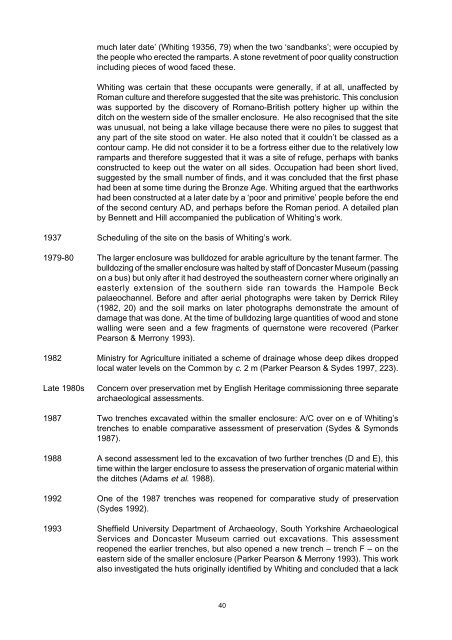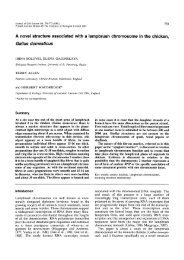Sutton Common Updated project design - University of Exeter
Sutton Common Updated project design - University of Exeter
Sutton Common Updated project design - University of Exeter
You also want an ePaper? Increase the reach of your titles
YUMPU automatically turns print PDFs into web optimized ePapers that Google loves.
much later date’ (Whiting 19356, 79) when the two ‘sandbanks’; were occupied by<br />
the people who erected the ramparts. A stone revetment <strong>of</strong> poor quality construction<br />
including pieces <strong>of</strong> wood faced these.<br />
Whiting was certain that these occupants were generally, if at all, unaffected by<br />
Roman culture and therefore suggested that the site was prehistoric. This conclusion<br />
was supported by the discovery <strong>of</strong> Romano-British pottery higher up within the<br />
ditch on the western side <strong>of</strong> the smaller enclosure. He also recognised that the site<br />
was unusual, not being a lake village because there were no piles to suggest that<br />
any part <strong>of</strong> the site stood on water. He also noted that it couldn’t be classed as a<br />
contour camp. He did not consider it to be a fortress either due to the relatively low<br />
ramparts and therefore suggested that it was a site <strong>of</strong> refuge, perhaps with banks<br />
constructed to keep out the water on all sides. Occupation had been short lived,<br />
suggested by the small number <strong>of</strong> finds, and it was concluded that the first phase<br />
had been at some time during the Bronze Age. Whiting argued that the earthworks<br />
had been constructed at a later date by a ‘poor and primitive’ people before the end<br />
<strong>of</strong> the second century AD, and perhaps before the Roman period. A detailed plan<br />
by Bennett and Hill accompanied the publication <strong>of</strong> Whiting’s work.<br />
1937 Scheduling <strong>of</strong> the site on the basis <strong>of</strong> Whiting’s work.<br />
1979-80 The larger enclosure was bulldozed for arable agriculture by the tenant farmer. The<br />
bulldozing <strong>of</strong> the smaller enclosure was halted by staff <strong>of</strong> Doncaster Museum (passing<br />
on a bus) but only after it had destroyed the southeastern corner where originally an<br />
easterly extension <strong>of</strong> the southern side ran towards the Hampole Beck<br />
palaeochannel. Before and after aerial photographs were taken by Derrick Riley<br />
(1982, 20) and the soil marks on later photographs demonstrate the amount <strong>of</strong><br />
damage that was done. At the time <strong>of</strong> bulldozing large quantities <strong>of</strong> wood and stone<br />
walling were seen and a few fragments <strong>of</strong> quernstone were recovered (Parker<br />
Pearson & Merrony 1993).<br />
1982 Ministry for Agriculture initiated a scheme <strong>of</strong> drainage whose deep dikes dropped<br />
local water levels on the <strong>Common</strong> by c. 2 m (Parker Pearson & Sydes 1997, 223).<br />
Late 1980s<br />
Concern over preservation met by English Heritage commissioning three separate<br />
archaeological assessments.<br />
1987 Two trenches excavated within the smaller enclosure: A/C over on e <strong>of</strong> Whiting’s<br />
trenches to enable comparative assessment <strong>of</strong> preservation (Sydes & Symonds<br />
1987).<br />
1988 A second assessment led to the excavation <strong>of</strong> two further trenches (D and E), this<br />
time within the larger enclosure to assess the preservation <strong>of</strong> organic material within<br />
the ditches (Adams et al. 1988).<br />
1992 One <strong>of</strong> the 1987 trenches was reopened for comparative study <strong>of</strong> preservation<br />
(Sydes 1992).<br />
1993 Sheffield <strong>University</strong> Department <strong>of</strong> Archaeology, South Yorkshire Archaeological<br />
Services and Doncaster Museum carried out excavations. This assessment<br />
reopened the earlier trenches, but also opened a new trench – trench F – on the<br />
eastern side <strong>of</strong> the smaller enclosure (Parker Pearson & Merrony 1993). This work<br />
also investigated the huts originally identified by Whiting and concluded that a lack<br />
40
















